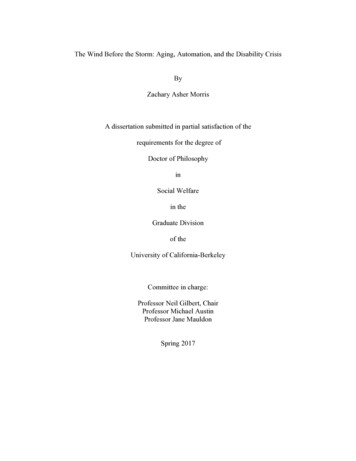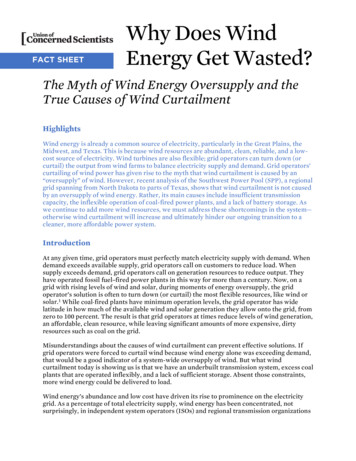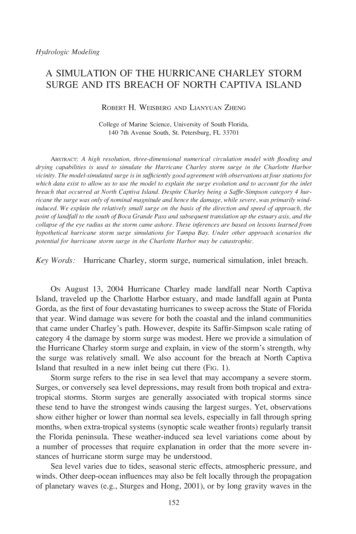
Transcription
The Wind Before the Storm: Aging, Automation, and the Disability CrisisByZachary Asher MorrisA dissertation submitted in partial satisfaction of therequirements for the degree ofDoctor of PhilosophyinSocial Welfarein theGraduate Divisionof theUniversity of California-BerkeleyCommittee in charge:Professor Neil Gilbert, ChairProfessor Michael AustinProfessor Jane MauldonSpring 2017
The Wind Before the Storm: Aging, Automation, and the Disability CrisisCopyright 2017 by Zachary Asher Morris. All rights reserved.
1AbstractThe Wind Before the Storm: Aging, Automation, and the Disability CrisisbyZachary Asher MorrisDoctor of Philosophy in Social WelfareUniversity of California-BerkeleyProfessor Neil Gilbert, ChairA substantial and growing share of the working age population of the advanced economies receivesdisability benefits. The causes of disability benefit expansion can primarily be attributed to anaging population and the deterioration of the low-skilled labor market due largely to technologicalchange – challenges that also promise to strain other social welfare programs in the future. Usingcontemporary international disability benefit reforms as a case study, this dissertation argues thata new welfare state settlement is needed that no longer assumes a sustainable male breadwinnereconomy. The first chapter traces the history of disability benefits and argues that the traditionalmodel for disability determination is ill suited for the post-industrial era. The second chapterprovides a comparative policy analysis of major reforms to the disability determination processesin Denmark, Great Britain, and the Netherlands that shifts away from the traditional model and toa model focusing on work-capacity. The third chapter explores the relevance of disability policiesin 17 OECD countries that attempt to integrate people with disabilities into the labor market andto reduce reliance on disability benefits. The dissertation concludes by summarizing the analysesand by returning to the major argument concerning the search for new policy solutions in the postindustrial welfare state.
iDedicationTo my parents who provided love and the freedom to wonder.
iiTable of ContentsAbstract . 1Dedication . iTable of Contents . iiAcknowledgment . iiiIntroduction. The Wind Before the Storm . 1Welfare State Resiliency and Adaptation .2The Purpose of the Welfare State .4The Post-Industrial Welfare State Settlement .6Chapter 1. Disability Benefits Meet the Post-Industrial Era. 8The Historical Antecedents to Modern Disability Benefits .9Disability Benefits and the “Take-Off Period” of the Welfare State .11The Medical/Binary Model in the Post-Industrial Era .14Chapter 2. Reforming the Disabled State . 16The Disability Determination Process in the United States .17The Work-Capacity Model .20Analysis of Work-Capacity Reforms in Denmark, Britain, and the Netherlands .23Discussion and .36Lessons for the United States .36Chapter 3. How Relevant are Integration Policies? . 38The Determinants of Disability Benefit Receipt .38Assessing the Significance of Integration Policies in 17 OECD Countries .43Summary of Findings .51Conclusion. Bracing for the Storm . 53Targeting versus Universalism .54Is Work the Right Goal? .56References . 60Appendix . 72
iiiAcknowledgmentI am indebted to many for their support and assistance with this research. I would like to firstthank my Dissertation Chair, Neil Gilbert. Neil has been a reliable source of brilliant ideas andsage advice. My most profound academic moments have occurred meeting (and arguing) withhim in his office or over a cup of coffee. I will forever be grateful for the opportunity to studyunder him. I would also like to thank my two superb committee members, Michael Austin andJane Mauldon. Both took an active role in my development and provided invaluable commentson this research and expert guidance over the years. Their thankless work made this dissertationfar better than it would be otherwise.Additionally, I would like to thank James Midgley for his valued mentorship and Jill DuerrBerrick for her work as the chair of the doctoral program. Jody Schimmel-Hyde and ToddHoneycutt provided fantastic supervision during my summer as a fellow at Mathematica PolicyResearch. Peter Kemp, my master’s degree supervisor at the University of Oxford, and MortonColeman, my undergraduate thesis advisor at the University of Pittsburgh, also deserveacknowledgment for their influence on my research path.A great deal of gratitude is also owed for financial support from the UC-Berkeley GraduateDivision, the Disability Research Consortium of the Social Security Administration, and theAustrian Marshall Plan Foundation. I am also grateful to the Vienna University of Economicsand Business, which hosted me for a summer as I prepared my dissertation. August Österle was agracious host during my time in Vienna and Stefan Angel has been a very helpful academicresource. Steen Bengtsson, Dorte Caswell, Malene Eskildsen, Jan Høgelund, Jon Kvist,Leif Olsen, and Lars Uggerhøj were kind to meet with me while traveling in Denmark and wereuseful experts on Danish disability policy. Thomas Carsey was also an excellent instructor ofmultilevel modeling at the Inter-University for Political and Social Research Summer Program atthe University of North Carolina and provided helpful comments on this research.Thanks also to my colleagues, Rachel Gartner, Leah Jacobs, Woojin Jung, Renee Mack, HannaMark, Stephanie Rennane, Nicky Schett, and Wendy Wiegman who provided exercisepartnership, statistical consultation, and friendship. My partner, Aramie Brooks-Salzman,deserves special recognition for her patience, humor, and much needed support throughout mywriting process. My mom, Robin, and sisters, Shira and Aliza, were constant sources ofencouragement and warmth. Finally, I would like to thank my father, Jeffery, for his editingprowess and ready availability to FaceTime.
ivThe research reported herein was performed pursuant to a grant from the U.S. Social SecurityAdministration (SSA) funded as part of the Disability Research Consortium. The opinions andconclusions expressed are solely those of the author(s) and do not represent the opinions orpolicy of SSA or any agency of the Federal Government. Neither the United States Governmentnor any agency thereof, nor any of their employees, makes any warranty, express or implied, orassumes any legal liability or responsibility for the accuracy, completeness, or usefulness of thecontents of this report. Reference herein to any specific commercial product, process or serviceby trade name, trademark, manufacturer, or otherwise does not necessarily constitute or implyendorsement, recommendation or favoring by the United States Government or any agencythereof.
1Introduction. The Wind Before the StormThe future of the welfare state is feared by many to be in jeopardy. Opinion polls showthat half of Millennials anticipate that they will receive no benefits from Social Security, thepillar of the US welfare state, when they retire.1 A representative survey of eight Europeancountries finds a similar level of gloom: more than 50 percent of the respondents in each countryare convinced that they will not receive old-age pensions by the year 2050.2This pessimism is not without merit, as the financial burden of supporting the welfarestate is shifting to the steadily shrinking share of adults that are employed. The population inmany Organization for Economic Cooperation and Development (OECD) and non-OECDcountries is rapidly aging with life expectancies increasing and fertility rates in decline (OECD,2015). By 2060, it is projected that 98 million people will be over the age of 65 in the US - morethan twice the number in 2014.3 The major social insurance programs that provide health careand old age pensions to millions of people are expected to be exhausted of funds in the nextdecade.4 Europe and Asia, particularly Japan, are in even deeper trouble with underfundedpension schemes and a shrinking ratio of workers to retirees (OECD, 2015).And population aging is not the only major looming concern. Technological change isthreatening to make more and more people unemployable with workers replaced by driverlesscars and trucks, drone delivery systems, and automated restaurants and grocery stores(Brynjofsson and McAfee, 2011; Ford, 2014). A recent study estimates that 47 percent of totalU.S. employment is at risk to computerized automation in the next 20 years (Frey and Osborne,2017). While the likelihood of a full-fledged artificial intelligence revolution is up for debate(Autor, 2015), wages are already stagnating for workers less capable of meeting the new skilldemands of the 21st century (Goldin and Katz, 2008) and precarious employment is on the rise(Katz and Kruegger, 2015). Though the coming storm of population aging and technologicalchange has yet to hit land, and the worst of its impact may still be averted, its incoming windsare clearly felt today, and there is no better example of this then the growth of enrollment indisability benefit programs.Nearly all the advanced economies have experienced a growing number of working ageadults receiving out of work disability benefits (OECD, 2003; 2010). For many countries,disability benefits are the largest form of social expenditure outside of old age pensions andhealth care. Cross-national spending on disability benefits are, on average, double the cost ofunemployment benefits (OECD, 2015). In the US, more than 10 million people with disabilitiesreceived Social Security Disability Insurance (DI) benefits in 2015 and the percentage of theworking-age population receiving these benefits has more than doubled since the late 1970s(Liebman, 2015). Consequently, that program faces a severe financial challenge as the trust fundthat finances the program is expected to be unable to fully provide disability benefit payments asearly as 2023 (Board of Trustees, 2016). These growth dynamics have spurred major reformefforts around the world, including in Australia, Britain, Denmark, Germany, the Netherlands,and Sweden (OECD, 2010; Burkhauser, McVicar, Daly, and Wilkins, 2015; Morris, /Aging um/2
2Indeed, reducing disability benefit rates and improving the labor market opportunities for peoplewith disabilities has emerged as a major international policy priority.Though a variety of factors have led to disability benefit expansion, population aging andtechnological change are two important factors (Stone, 1984; Rupp and Stapleton, 1998; OECD,2003; 2010). The aging of the baby-boomer population has intensified the demand for disabilitybenefits, as people become more likely to develop work-limiting disabilities in their olderworking years (Liebman, 2015). At the same time, the increasing insecurity of work for peoplewith low skills, largely attributable to technological change, has made disability benefits theoption of last resort for those with health issues who in a stronger economy could stay in work(Beatty and Fothergill, 1996; Autor and Duggan, 2003; Black, Sanders, and Daniels, 2003;Banks et al., 2015). The growing share of the working-age population receiving disabilitybenefits thus portends a looming crisis in the broader welfare state. And as a forerunner to thiscrisis, its policy solutions can provide insights for how the welfare state can cope with theintensifying challenges of population aging and a declining low skilled labor market.Welfare State Resiliency and AdaptationBut does the welfare state have the capacity to address these challenges? Will an agingpopulation and the loss of jobs due to technological change so overwhelm the systems of welfarestate support that they collapse entirely? These concerns should be examined skeptically in thecontext of other previous challenges to the welfare state. After all, for as long as there has been awelfare state, there have been those predicting its inevitable dismantling.In the Fiscal Crisis of the State, James O’Connor (1973) argued that the capitalist staterequires that governments promote the contradictory aims of private accumulation and sociallegitimacy obtained through redistributive welfare transfers. These competing imperatives, heprojected, would lead to a fiscal crisis where the expenditures of the welfare state outpacegovernment revenues. Reacting to the “democratic surge” of the 1960’s, Samuel Huntingtonsimilarly predicted that the welfare state will precipitate a crisis of governance, as the publicdevelops expectations that are impossible for the government to meet (Huntington, 1975). DanielBell (1976) viewed the materialist and anti-intellectual impulses of modernity present in the1970s as an underlying threat to the social cohesion needed to uphold a welfare state. Thepessimism of these scholars is, as Myles and Quadagno (2002) suggest, a reflection of thechallenges of their time. Each was writing in the 1970s, a time of industrial decline that sawrising unemployment and a global oil crisis. Yet, despite their dire predictions, as well as thepolitical efforts of Reagan and Thatcher to dismantle the welfare state, the welfare state of theadvanced economies remained a primary component of government budgets throughout the 20thcentury (Pierson, 1996).Nearly forty years after the crisis years of the 1970’s, the welfare state hit anotherpossible breaking point with the Great Recession of 2008. Surpassing the economic turmoil ofthe 1970s, the Great Recession was widely considered the greatest economic crisis since theGreat Depression. Predictions of the welfare state’s demise again surfaced. Paul Pierson rang thealarm in suggesting that, given the financial uncertainty caused by the recession, governmentsmay be entering a “real era of retrenchment” (Pierson, 2011, 21). For other scholars, austeritymeasures that scaled back welfare state programs became viewed as the only viable policy optionin light of the substantial fiscal constraints (Armingeon, 2013). Yet, in 2017, nearly a decade
3after the recession, the welfare state stands largely intact. Surveys of the post-recession socialpolicy landscape reveal government measures that resisted cuts to the welfare state (Starke,Kaasch and Van Hooren, 2013; Kersbergen et al, 2014). Some governments even increasedinvestment in active labor market policies and childcare subsidies following the downturn andothers expanded their core income support programs (Kersbergen et al, 2014). The welfare state,despite major obstacles to its sustainability and the dire predictions of scholars, has thusremained stubbornly in place.Explaining Welfare State ResiliencyOne can identify three perspectives for explaining the resilience of the welfare state. Aninstitutionalist perspective posits that once a social welfare policy or program is established andultimately institutionalized it becomes very difficult to cut back. Its adoption generates a “policyfeedback effect” that can “transform politics and, as a result, influence future courses of policydevelopment,” (Moynihan and Soss, 2014). Beneficiaries of a social welfare program, forexample, become a concentrated interest group that will go to great lengths to protect a programfrom retrenchment (Olson, 1965; Pierson, 1996). In the US, the classic example is the politicalinfluence of the American Association of Retired People and its ability to defend cuts to old ageentitlement and health insurance programs. A negativity bias or general aversion to loss, wellestablished in behavioral economics (Kahneman and Tversky, 1979), also explains whypoliticians have a harder time persuading voters of the need to cut back a welfare state programthan to expand it (Pierson, 1996). These policy feedback effects, according to this institutionalistperspective, ultimately create a welfare state that is path dependent or “sticky” and thusimpervious to radical change.A second perspective views the welfare state as vital to the functioning of the capitalistsystem and thus impossible to eliminate. That the market economy is prone to severedownswings is obvious to the early 21st century observer. Also apparent is the role that thewelfare state plays in mitigating the crisis tendencies of capitalism (Piven and Cloward, 1973;Peck, 2001; Starke, Kaassch, & Van Hooren, 2013). In response to the Great Recession, forexample, many countries expanded eligibility to unemployment benefits. While a clear effort toexpand social protection in a time of great need, such measures also very likely prevented socialunrest and democratic upheaval. Yet, capitalism and the welfare state have typically been viewedin conflict. Whatever benefits the welfare state bestows, conservatives argue, increased taxationand regulation, restrain the profitability of firms and disincentivize individuals from working(Murray, 1984). This tension creates what Claus Offe (1984) has called the major contradictionof the welfare state: “that while capitalism cannot coexist with the welfare state, neither can itexist without the welfare state.”A third perspective views the political and economic explanations noted above as factorsthat prevent the wholesale retrenchment of the welfare state. Instead of observing welfare statechange as a zero-sum expansion or contraction of social protection, this view sees changes asoccurring multi-dimensionally (Pierson, 1996; Seeleib-Kaiser, 2008; Bonoli and Natali, 2012).Bonoli and Natali (2012, 292-293) identify three dimensions of welfare state change in the postindustrial period. The first concerns the level of protection and the quantity of social welfaretransfers that are provided. This dimension concerns formally cutting back the quantity ofexpenditures, by, for example, raising the retirement age as a means of cost-containment. The
4second-dimension concerns a “pro-employment orientation.” This involves the recognition ofnew social policy instruments, such as active labor market policies that increase theemployability of unemployed workers and tax credits that can increase their earnings. Theseefforts ultimately aim to “recommodify” (Pierson, 1996) individuals traditionally excluded fromthe labor market and place them back into the labor force in order to promote social inclusionand reduce reliance on welfare state programs (Lodemel and Trickey, 2001). Bonoli and Naftalirefer to their third dimension as changes to the “encompassing character” or the “extent ofcoverage” of the welfare state. For instance, some welfare states, will provide greater protectionto insiders (those employed) than outsiders (those not employed) (Emmenegger et al., 2011).Other welfare states will “de-universalize” (Bonoli and and Naftali, 2012) in other ways, by, forexample, targeting their systems of social protection towards those in the greatest need, whilerestricting public support to those with greater resources. And still other social welfare programswithin the welfare state, such as disability benefit programs, incrementally expand their coverageand thereby transform in order to meet changing societal circumstances.This third multidimensional perspective, more so than the others, emphasizes humanagency exercised by policy leaders, policy implementers, program beneficiaries, and activecitizens. Contrary to the crisis theories predicting the inevitable dismantling of the welfare state,this perspective fundamentally views humans as “nearly infinitely adaptable” (Stone, 1984, 189).It thus views the welfare state much like an evolving organism that responds, both reactively andproactively, to new problems that emerge such as the economic burden of an aging population orthe labor market turbulence associated with deindustrialization and technological change(Esping-Andersen, 1999; Taylor-Gooby, 2004; Gilbert, 2002; Seeleib-Kaiser, 2008; Marin,2013). These reactions, moreover, are understood as evolving on the basis of prior institutionalstructures and in response to policy feedback effects. Though applying new social policyinstruments to these emerging problems may amount to a shift towards a different kind ofwelfare state (Cox, 1998; Gilbert, 2002; Bonoli and Natali, 2012), that change is bettercharacterized as a form of welfare state restructuring than as a tearing down of the basic socialprotection infrastructure (Pieson, 2001).The Purpose of the Welfare StateAs the welfare state evolves, it is important to consider how it deviates from its originalpurpose and whether it remains true to its fundamental principles. To do so, we must first askwhat the welfare state was initially designed to do. In his classic essay, T.H. Marshall (1950)describes the development of the welfare state as an extension of the civil and political rights towhich the modern citizen was already entitled. For Marshall (1950), these “social rights” consistof, “the right to the modicum of economic welfare and security to the right to share to the full inthe social heritage and to live the life of a civilized being according to the standards prevailing inthe society.” Social rights protect citizens from the vagaries of the market economy by offeringworkers protection from market forces, most commonly in the form of partial earningsreplacement that provides income when a person cannot be sustained through his or her labor(Esping-Andersen, 1990).Another way of viewing this traditional purpose of the welfare state is as a solution towhat Deborah Stone (1984) calls “the fundamental distributive dilemma.” Stone argues that in allmodern societies there is a political tension between work-based and need-based systems ofdistribution. On the one hand, most people are expected to work to maintain their livelihoods, as
5this maximizes productivity, allows for an economic surplus, and encourages self-sufficiency.But, on the other hand, there will always be people who at one time or another are unable to meettheir needs through the work-based system, such as the young, unemployed, disabled, or elderly.The welfare state is created to support these needy populations by exempting them from thework-based system. And because of the accepted notion that most people would not work if theyhad sufficient resources, various “categories of need” (e.g. “disabled”, “unemployed”) weredeveloped to determine who is eligible for need-based aid and who must work to sustainthemselves (Stone, 1984). These categories, which are restricted by eligibility criterion, policethe boundaries of the work/need distributive systems. Politically constructed, they are neitheruniversal nor static but culturally specific and subject to change over time. As Stone (1984:17)argues, “there is no natural boundary between the two systems, no inherent definition of whatconstitutes need or who ‘belongs’ in one system or the other. Rather, the boundary is somethingthat each society has to invent, to redesign in the face of changing social conditions, and toenforce.”Figure 1. The Search for New Solutions to the Fundamental Distributive DilemmaThe traditional welfare state settlementWorkThe post-industrial welfare state settlementNeedNeedWorkCareIn Figure 1, the traditional welfare state is characterized as providing a dual resolution toStone’s fundamental distributive dilemma between work and need. Underlying this dualresolution was a male breadwinner economic system, in which men could be expected to findgainful employment independent of their level of skill or education. It was also a model wherewomen were, for the most part, expected to provide unpaid familial care. Care was viewed asoutside the work/need distributive dilemma, as it was provided for internally within the familialstructure. Welfare states were designed to protect against the labor market risks to the malebreadwinner. As Myles and Quadagno (2002, 48) argue, “The single-wage-earner family formwas at the center of the risk structure of postwar industrial economies, threatening catastrophewhen the male breadwinner lost his job as a result of illness, unemployment, or old age.”Unemployment benefits thus provided men a source of income when they could not find work.Disability benefits and old age pensions similarly provided support when men could not workdue to an impairment or the infirmities of old age. Women could receive welfare or widowbenefits but only in the case of single motherhood or when there was no male breadwinner. Malelabor force participation was thus central to the design of the risk protection system (EspingAndersen, 1990; Lewis, 1992). Need was, moreover, typically viewed as a binary state. Eitherbenefits were necessary because the male breadwinner could not participate in the labor market,
6or benefits were not needed because work would provide a man and his family enough to makeends meet.The Post-Industrial Welfare State SettlementIn the post-industrial era, the welfare state settlement is far more complex. The malebreadwinner economic system, in which care was recognized as a familial concern and jobs wereviewed as sustainable, has diminished. In 1945, just 28 percent of the civilian labor force in theUS were women but by 2015 it had grown to 47 percent.5 The revolutionary shift in notions ofwork and care has unlocked the potential for women to contribute their skills to the labor market.A recent study estimates that if the labor market participation rate of women had not changedover the past thirty years, the US GDP would have been roughly 11 percent lower in 2012(Applebaum, Boushey, and Schmitt, 2014). While providing substantial economic gains, theincrease in female labor force participation also brings forth new challenges in the provision ofcare (Esping-Andersen, 1999; Taylor-Gooby, 2004; Armingeon and Bonoli, 2006; Gilbert,2010). The need for caregiving services, whether provided directly by the market through agrowing caregiver workforce or through government provision and subsidy, has thus become anessential component of the distributive dilemma.Notions of what people in the need-based category, particularly people with disabilitiesas well as mothers who are the primary caregivers for children are capable of doing in the labormarket have also transformed. Many individuals traditionally relegated to that category are nowwilling and able to work with the appropriate support and accommodations (Livermore, 2011;Maestas, Mullen, and Strand, 2013). Disability rights advocates have, for example, long arguedthat people with disabilities can contribute to the labor market and should therefore not bediscriminated against on the basis of their disabilities nor face other social or environmentalbarriers to employment (Barnes, 2000; Dorfman, 2016). Advancements in modern medicine andassistive technologies further allow many people with even severe impairments to participatemeaningfully in the labor market (Stapleton, O’Day, & Livermore, 2006). Welfare states havethus further transformed in their orientation from providing passive support to actively assistingthose traditionally placed in need-based categories in their return back to employment (Gilbert,2002). A famous example of this is the 1996 welfa
2017). While the likelihood of a full-fledged artificial intelligence revolution is up for debate (Autor, 2015), wages are already stagnating for workers less capable of meeting the new skill demands of the 21st century (Goldin and Katz, 2008) and precarious employment is on the rise (Katz and Kruegger, 2015).











